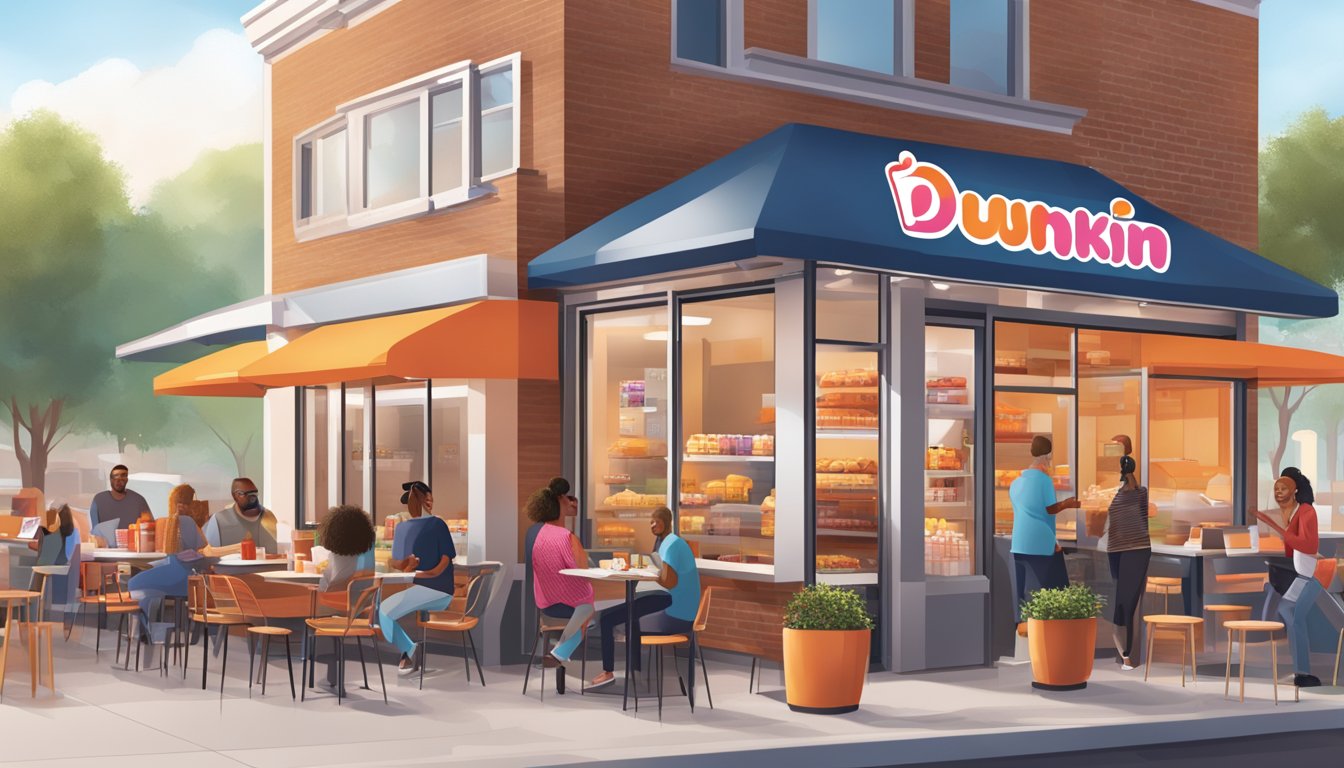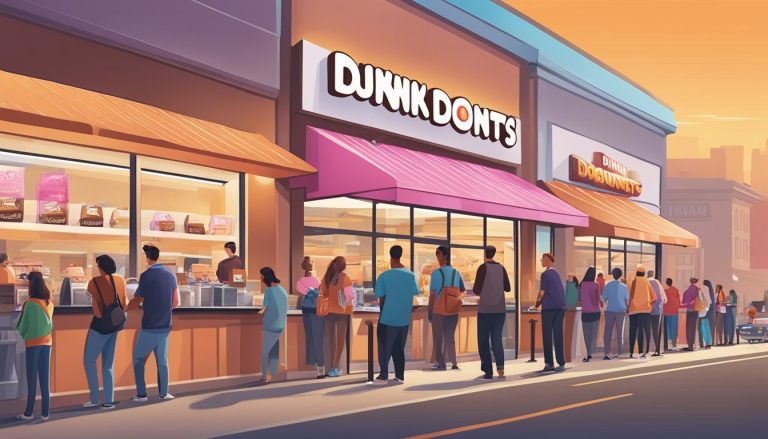Dunkin’ has undergone a significant transformation in recent years, evolving from a traditional donut shop to a modern breakfast destination. The company has embraced changing consumer preferences and adapted its offerings to meet the demands of today’s health-conscious and trend-savvy customers.
By expanding its menu, enhancing its coffee selection, and revamping its brand image, Dunkin’ has positioned itself as a versatile quick-service restaurant catering to diverse tastes and dietary needs. This article explores nine key ways Dunkin’ has stayed relevant in the competitive breakfast market, highlighting the strategies that have helped the company maintain its popularity among consumers of all ages.
1) Expanding Veggie Egg White Options

Dunkin’ has embraced the growing demand for healthier breakfast options by expanding its menu of veggie egg white offerings. The chain introduced the Egg White & Veggie Egg Bites, catering to customers seeking lighter, protein-rich choices.
These egg bites provide a convenient, portable option for health-conscious consumers on the go. They offer a balance of nutrients and flavors without the need for a full sandwich.
Dunkin’ also launched the Southwest Veggie Power Breakfast Sandwich, featuring a vegan black bean patty and egg whites. This addition demonstrates the company’s commitment to incorporating plant-based proteins and catering to vegetarian customers.
The sandwich combines the nutritional benefits of egg whites with the heartiness of a veggie patty. It aims to satisfy those looking for a filling breakfast without sacrificing health goals.
By expanding its veggie egg white options, Dunkin’ has positioned itself to attract a wider range of customers. These menu items appeal to health-focused individuals, vegetarians, and those simply looking to reduce their meat consumption.
2) Introducing Beyond Sausage Sandwich
Dunkin’ made waves in the breakfast industry by partnering with Beyond Meat to launch the Beyond Sausage Sandwich. This innovative offering features a plant-based sausage patty served on an English muffin.
The sandwich caters to health-conscious consumers and those seeking meat alternatives. It contains 10 grams of plant-based protein and boasts lower fat, calorie, and sodium content compared to traditional sausage sandwiches.
Dunkin’ initially tested the Beyond Sausage Sandwich in select locations before rolling it out nationwide in November 2019. This move made Dunkin’ the first major U.S. restaurant chain to offer Beyond Meat’s breakfast sausage.
The sandwich can be customized to suit various dietary preferences. Customers can order it with or without egg and cheese, allowing for vegan and vegetarian options.
By introducing the Beyond Sausage Sandwich, Dunkin’ demonstrated its commitment to adapting to changing consumer tastes and dietary trends. The company aimed to attract a broader customer base while maintaining its position as a breakfast leader.
3) Implementing Digital Order Systems

Dunkin’ has embraced digital ordering to streamline customer experiences and adapt to changing consumer habits. The company introduced mobile ordering through its app, allowing customers to place orders in advance and skip lines.
This digital system integrates with Dunkin’s rewards program, enabling customers to earn and redeem points easily. The app also provides personalized offers based on individual purchase history.
In-store kiosks have been installed in many locations, giving customers another convenient way to place orders without interacting with staff. These self-service options have proven particularly popular during busy periods.
Dunkin’ has also partnered with third-party delivery services to expand its reach. Customers can now order their favorite items through platforms like DoorDash and Grubhub for home or office delivery.
The company’s digital initiatives have paid off, with online orders more than doubling within the first year of implementing a unified ordering solution. This growth trend has continued, demonstrating the success of Dunkin’s digital strategy.
4) Launching Snackin’ Bacon

Dunkin’ introduced Snackin’ Bacon as a new menu item in response to changing breakfast trends. This portable snack consists of eight half-strips of high-end bacon wrapped in a convenient sleeve for on-the-go consumption.
The bacon is smoked with natural cherrywood and treated with Dunkin’s signature sweet and savory blend of brown sugar and black pepper seasoning. This combination creates a unique flavor profile that appeals to bacon enthusiasts.
Priced at $2.79, Snackin’ Bacon offers customers a protein-rich option that can be enjoyed throughout the day. Each serving contains 190 calories, 12 grams of fat, 10 grams of carbs, and 9 grams of sugar.
Dunkin’ has also introduced seasonal variations of Snackin’ Bacon. A fall-themed version features maple sugar seasoning, catering to customers who enjoy seasonal flavors.
By launching Snackin’ Bacon, Dunkin’ has positioned itself to capture a share of the snacking market while maintaining its focus on breakfast offerings. This move demonstrates the company’s ability to adapt to evolving consumer preferences and eating habits.
5) Offering Almond Milk as a Dairy Alternative

Dunkin’ introduced almond milk as a non-dairy option in 2014, responding to growing consumer demand for plant-based alternatives. This move allowed the company to cater to customers with lactose intolerance, milk allergies, or those following vegan diets.
Almond milk quickly became a popular choice among Dunkin’ patrons. It offers a smooth, nutty flavor that complements coffee and tea beverages well. The addition of this dairy-free option expanded Dunkin’s customer base and showed the company’s willingness to adapt to changing dietary preferences.
Dunkin’ charges a small fee for almond milk substitutions, typically around 50 cents per drink. This pricing strategy helps offset the higher cost of almond milk compared to traditional dairy options.
The introduction of almond milk aligns with broader trends in the plant-based milk market. Sales of alternative milks have seen significant growth in recent years, with almond milk being a top choice among consumers.
By offering almond milk, Dunkin’ positions itself as a more inclusive brand, accommodating a wider range of dietary needs and preferences. This move has helped the company stay competitive in the evolving breakfast and coffee market.
6) Redesigning Store Interiors for Comfort

Dunkin’ has undertaken a significant redesign of its store interiors to create a more comfortable and inviting atmosphere for customers. The new design incorporates warmer colors, updated furniture, and improved lighting to enhance the overall ambiance.
The reimagined spaces feature open layouts that allow for better flow and increased natural light. This creates a more welcoming environment for guests who prefer to linger and enjoy their purchases on-site.
Seating areas have been updated with modern furniture and improved lighting fixtures. Dunkin’ has also added electrical outlets to accommodate customers who wish to work or charge their devices while visiting.
The redesigned stores maintain Dunkin’s focus on efficiency while providing a more relaxed setting for those seeking a longer visit. This balance allows the brand to cater to both on-the-go customers and those looking for a coffeehouse experience.
By updating its interior design, Dunkin’ aims to compete more effectively with other coffee chains that have traditionally offered more comfortable seating areas. This strategy helps position the brand to attract customers across various dayparts and preferences.
7) Expanding All-Day Breakfast Menu

Dunkin’ has adapted to changing consumer preferences by expanding its all-day breakfast offerings. The company recognized that many customers desire breakfast foods outside of traditional morning hours.
This shift allows patrons to enjoy their favorite breakfast items at any time of day. Dunkin’ now serves its popular breakfast sandwiches, wraps, and other morning staples throughout its operating hours.
The expanded menu includes classics like bacon, egg, and cheese sandwiches, as well as newer additions such as breakfast tacos. This move caters to diverse schedules and eating habits.
By offering breakfast all day, Dunkin’ has positioned itself to compete more effectively with other fast-food chains. It also provides greater flexibility for customers with non-traditional work hours or those who simply crave breakfast foods later in the day.
This strategy aligns with broader industry trends, as many consumers now expect breakfast options to be available beyond morning hours. Dunkin’s adaptation demonstrates its responsiveness to evolving customer needs and preferences.
8) Partnering with Delivery Services

Dunkin’ has embraced the rising demand for food delivery by forging strategic partnerships with third-party delivery services. This move has significantly expanded the brand’s reach and convenience for customers.
Over the past five years, Dunkin’ has rapidly increased its delivery capabilities. The company now offers delivery from over 6,000 locations across 45 states, with plans for continued expansion.
Dunkin’ has partnered with popular platforms like Uber Eats to make its menu items more accessible. Through Uber Eats alone, delivery is available from over 1,700 Dunkin’ restaurants, with plans to reach 4,000 locations nationwide.
These partnerships allow customers to enjoy Dunkin’s coffee, baked goods, and breakfast items without leaving their homes or offices. The convenience of delivery aligns with changing consumer preferences for on-demand food options.
By leveraging third-party delivery services, Dunkin’ has adapted to evolving breakfast trends and maintained its competitive edge in the quick-service restaurant industry. This strategy has helped Dunkin’ meet customer needs and drive growth in an increasingly digital marketplace.
9) Developing New Cold Brew Flavors

Dunkin’ has embraced the cold brew coffee trend by continually introducing innovative flavors and variations. The company’s culinary team has focused on creating unique combinations to complement their classic Cold Brew offering.
One notable addition is the Brown Sugar Cold Foam, designed to pair perfectly with Dunkin’s Cold Brew. This velvety topping joins other popular options like the Sweet Cold Foam and past creations such as Salted Caramel Cold Foam.
Dunkin’ has also introduced seasonal specialties to keep customers engaged. The Cookie Butter Cold Brew, a fan favorite, has returned for its third year as part of the holiday menu lineup.
For summer refreshment, Dunkin’ developed the Smoked Vanilla Cold Brew with Sweet Cold Foam. This beverage combines smoky vanilla notes with the rich flavor of their signature Cold Brew, topped with Sweet Cold Foam and hot chocolate powder.
These new cold brew flavors demonstrate Dunkin’s commitment to adapting to changing consumer preferences and staying competitive in the evolving breakfast market.
Understanding Breakfast Trends

Breakfast habits have undergone significant shifts in recent years. Consumer preferences now lean towards healthier options and convenient on-the-go choices that fit busy lifestyles.
Rise of Health-Conscious Choices
Nutritious breakfast options have gained popularity among consumers. Whole grain products, protein-rich foods, and plant-based alternatives are in high demand. Many seek low-sugar, high-fiber items to start their day.
Egg white sandwiches, Greek yogurt parfaits, and oatmeal bowls have become menu staples. Smoothies packed with fruits, vegetables, and supplements offer a quick nutrient boost. Avocado toast has emerged as a trendy, Instagram-worthy breakfast choice.
Health-focused chains now highlight calorie counts and ingredient sourcing. Gluten-free, dairy-free, and vegan options cater to diverse dietary needs. This shift reflects a growing awareness of nutrition’s impact on overall wellness.
The Move Toward Convenience
Fast-paced lifestyles have fueled demand for grab-and-go breakfast items. Portable options like breakfast sandwiches, wraps, and burritos have surged in popularity. Many consumers prioritize speed and ease over sit-down meals.
Mobile ordering and drive-thru services have become essential for quick breakfast pickup. Chains offer all-day breakfast menus to accommodate varied schedules. Meal prep and subscription services deliver ready-to-eat breakfast items to homes and offices.
Convenience stores have expanded their breakfast offerings, competing with traditional fast-food chains. Single-serve coffee pods and instant oatmeal cups provide quick at-home solutions. This trend underscores the value placed on time-saving breakfast options in today’s fast-paced world.
Dunkin’ Innovations in Menu Offerings
Dunkin’ has consistently expanded its menu beyond traditional donuts to meet evolving consumer preferences. The company now offers a diverse range of breakfast sandwiches, bagels, and muffins to cater to changing tastes.
Product innovation remains a key focus for Dunkin’. The brand regularly introduces limited-time offers to generate excitement and drive customer traffic. These seasonal and specialty items keep the menu fresh and interesting.
Some notable menu additions include:
- Breakfast bowls with eggs, cheese, and vegetables
- Plant-based options like Beyond Sausage breakfast sandwiches
- Cold brew coffee and nitro cold brew
- Flavored iced teas and refreshers
Dunkin’ has also embraced healthier options to appeal to more health-conscious consumers. Lower-calorie items and snacks made with whole grains have been added to provide more nutritious choices.
The expansion into premium coffees and espresso-based drinks demonstrates Dunkin’s evolution as a beverage destination. Lattes, cappuccinos, and macchiatos now feature prominently alongside their classic drip coffee.
By continuously innovating its menu, Dunkin’ aims to stay relevant in the competitive breakfast and coffee market. The brand balances introducing new items with maintaining its core offerings to satisfy both adventurous and traditional customers.




